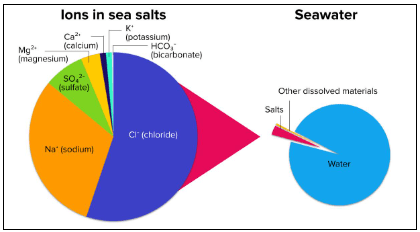The tiny structures that make up all living things on Earth.
They are often referred to as the smallest units of life.
What are cells?
Organisms that are able to make their own food (Ex: oak tree).
What are producers?
These particles are what all matter is made up of.
What are atoms?
The three states of matter.
What are solids, liquids, and gases?
A substance that is solid, has a pure chemical composition, a regular crystal structure, is naturally occurring, and is inorganic in origin.
What is a mineral?
The idea that the 7 continents used to be one supercontinent, known as Pangaea, and have been moving further apart over the last 200-300 millions of years.
What is Continental Drift?
An organism with one cell.
What are unicellular organisms?
Organisms that rely on other organisms (either plants or animals) for food.
What are consumers?
The amount of hydrogen atoms that are found in the chemical formula C6H12O6.
There are 12 hydrogen atoms.
The phase change that occurs when a liquid becomes a gas.
What is evaporation?
The three types of rock.
What are sedimentary, metamorphous, and igneous rock?
The idea that we use to explain how liquids and gases move in the following way: hotter molecules rise, become cooler, then move downward.
What are convection currents?
An organism with more than one cell.
What is a multicellular organism?
The term used to describe the action of organisms relying on the same resources in an ecosystem.
What is competition?
The type of mixture that has evenly distributed particles throughout (ex: salt water)
What is a homogeneous mixture?
The phase change that occurs when a gas becomes a liquid.
What is condensation?
Any rock can become these through weathering and erosion.
What are sediments?
The plate boundary could that earthquakes occur at.
What is a transform plate boundary?
The inevitable effect of an organism’s resources become limited or completely taken away.
What is extinction?
What is a decrease in the population?
This is the body system that contains the esophagus and liver.
What is the digestive system?
Methoxyethane and Isopropyl Alcohol both are made up of 3 carbons atoms, 8 hydrogen atoms, and 1 oxygen atom. Although they are made up of the same atoms, their structure is different. Are these substances considered the same?
They are not the same substance.
The way you can separate a mixture of sand and shells.
What is hand-picking?
Or
What is sifting?
The principle that states in a series of rock layers, the oldest layer is on the bottom and the youngest layer is on the top.
What is the Principle of Superposition?
A large, harbor wave that occurs as a results of an earthquake that can cause millions/billions of dollars of damage.
What is a tsunami?
The balance of an organism's internal environment.
What is homeostasis?
The type of digestion(s) that happens in the mouth.
What are chemical and mechanical/physical digestion?
The chemical formula of sodium sulfate.

What is Na2SO4?
Evaporation of water OR using a fine filter.
A fossil of a common ancestor shared by both apes and humans, was found in 2001. The fossil is 7 million years old. Fossils of ammonites, aquatic animals, have been aged at 450 million years old.
What is the common ancestor's fossil's relative age?
Younger than ammonites.
The pieces of the ocean floor that you would expect to be the youngest.
The ocean floor closest to a ridge (ex: Mid-Atlantic Ridge).